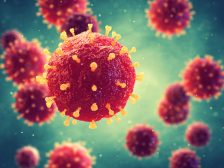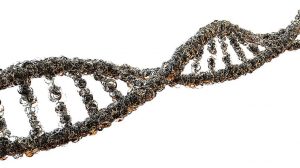Table of Contents
Definition
noun
plural: adenosine monophosphates
(biochemistry) A nucleotide composed of adenine, ribose and a phosphate group; an ester of phosphoric acid and the nucleoside adenosine, and with a chemical formula: C10H14N5O7P
Details
Overview
A nucleotide is an organic compound made up of three subunits: a nucleobase, a five-carbon sugar, and a phosphate group. The sugar component may either be ribose or deoxyribose. The ribose sugar is the sugar component of the nucleotides that make up RNA. The deoxyribose sugar is the sugar component of DNA. Nucleotides are the monomeric units of nucleic acids. Each phosphate group connects the sugar rings of two adjacent nucleotide monomers. The phosphate groups and the sugar moieties form the backbone of a nucleic acid. The directionality of the chain runs from 5′-end to 3′-end. In DNA, the orientation of the two strands is in opposite directions. This is to allow complementary base pairing between nucleobase constituents. Apart from the long chain of nucleic acids, nucleotides also occur in cyclic forms. Cyclic nucleotides form when the phosphate group is linked twice to the sugar moiety, particularly to the two hydroxyl groups of the constituent sugar.
A nucleotide is, thus, a nucleoside with a phosphate group. Depending on the number of phosphate groups attached to the sugar moiety. It may be called nucleoside monophosphate (if with only one phosphate group), nucleoside diphosphate (with two phosphate groups), or nucleoside triphosphate (when with three phosphate groups).
Depending on the pentose sugar component, a nucleoside may be a ribonucleoside or a deoxyribonucleoside. A ribonucleoside is a nucleoside with a ribose sugar component. Depending on the nucleobase component, the ribonucleoside may be adenosine, guanosine, cytidine, uridine, or 5-methyluridine. A deoxyribonucleoside is a nucleoside with a deoxyribose sugar. Depending on the nucleobase component, a deoxyribonucleoside may be deoxyadenosine, deoxyguanosine, deoxycytidine, thymidine, or deoxyuridine. Also, depending on the nucleobase component, the nucleosides may be grouped into either the “double-ringed” purine or the “single-ringed” pyrimidine.
Structure
Adenosine monophosphate (AMP) is a nucleoside phosphate in being comprised of a ribonucleoside and one phosphate group. It means, it has a ribose as its sugar and one phosphate group attached. Its nucleoside contains a purine base, i.e. an adenine attached to the ribose sugar. It has only one phosphate group attached to the nucleoside.
Adenylic acid is a condensation product of adenosine and phosphoric acid. It is a nucleotide found among the hydrolysis products of all nucleic acids. 3′-adenylic acid (adenosine 3′-monophosphate) and 5′-adenylic acid (adenosine 5′-monophosphate) differ in the place of attachment of the phosphoric Acid to the d-ribose. Deoxyadenylic acid differs in having H instead of OH at the 2′ position of d-ribose.
Common biological reactions
Common biological reactions
AMP may be produced as an end-product of certain biochemical reactions. One way is through combining two molecules of ADP during ATP synthesis by the action of the enzyme adenylate kinase: 2 ADP → ATP + AMP. Another is through hydrolysis of one inorganic phosphate of ADP: ADP → AMP + Pi. It may also be produced through the hydrolysis of ATP into AMP and pyrophosphate: ATP → AMP + PPi. Apart from biosynthesis, AMP may also be derived from dietary sources, particularly those rich in RNAs. The degradation of RNA leads to the formation of various nucleoside monophosphates, including AMPs. AMP, in turn, is degraded by converting it ultimately into uric acid that in mammals is excreted from the body.
Biological functions
AMP is used as a monomer in RNA. It may also be used to regenerate adenosine triphosphate (ATP): i.e. from the chemical reaction AMP + ATP → 2 ADP then ADP + Pi → ATP. ATP is a nucleotide that contains a large amount of chemical energy stored in its high-energy phosphate bonds. The energy is used for many metabolic processes. Hence, ATP is considered as the universal energy currency for metabolism. Its functions are for intracellular energy transport for various metabolic processes including biosynthetic reactions, motility, and cell division.
AMP may also serve as a source of inosine monophosphate (IMP). It is sometimes converted into IMP with the catalytic action of myoadenylate deaminase. AMP may also be converted into uric acid that is excreted from the body.
AMP may also occur as a cyclic structure, cyclic AMP that serves as a second messenger for signal transduction at the cellular level. In particular, it is used in transferring into cells the effects of glucagon and adrenaline. These hormones cannot pass through the plasma membrane of target cells and therefore need cAMP as a second messenger. It works by activating protein kinase A (PKA). Apart from the intracellular signal transduction, cAMP is also used for the regulation of the passage of calcium ions through ion channels. It also serves as an extracellular morphogen for some slime moulds.
In mammals, the enzyme 4-AMP-activated protein kinase (AMPK) uses AMP during high cellular energy expenditure (e.g. exercise). AMP is presumed to act as a direct agonist of AMPK. The AMPK carries out an important physiological role in the regulation and maintenance of ATP levels to ensure proper functioning of living cells. The binding of AMP (as well as of ADP) to the AMPK leads to the stimulation of hepatic fatty acid oxidation, ketogenesis, enhanced glucose uptake, inhibition of cholesterol synthesis, inhibition of lipogenesis, inhibition of triglyceride synthesis, and modulation of insulin secretion by the pancreatic beta-cells.1
Supplementary
Abbreviation(s)
- AMP
IUPAC
Chemical formula
- C10H14N5O7P
Also called
Further reading
See also
- nucleotide
- DNA
- RNA
- adenosine
- deoxyadenosine monophosphate (dAMP)
- cyclic adenosine monophosphate (cAMP)
- adenosine diphosphate
- adenosine triphosphate
Reference
- Winder, W. W. & Hardie, D. G. (July 1999). “AMP-activated protein kinase, a metabolic master switch: possible roles in type 2 diabetes”. Am. J. Physiol. 277 (1 Pt 1): E1–10. doi:10.1152/ajpendo.1999.277.1.E1
© Biology Online. Content provided and moderated by Biology Online Editors







